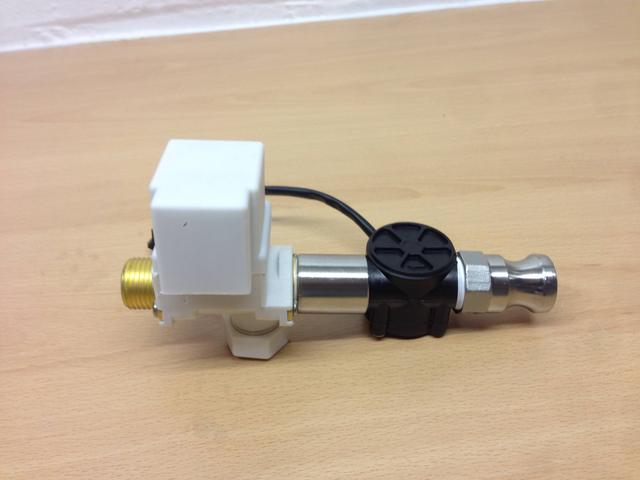////////////////////////////////////////////////////////////////////////////
// BrewShark v1 //
// Change value of hltSIZE to match the max volume in your HLT //
// //
////////////////////////////////////////////////////////////////////////////
#include <LiquidCrystal.h>
LiquidCrystal lcd(8, 9, 4, 5, 6, 7);
int lcd_key = 0;
int adc_key_in = 0;
float target_volume = 23;
float current_volume = 0;
#define btnRIGHT 0
#define btnUP 1
#define btnDOWN 2
#define btnLEFT 3
#define btnSELECT 4
#define btnNONE 5
#define hltSIZE 50 //Size of the Hot Liquor Tun in litres
#define SOLENOIDPIN 1
#define FLOWSENSORPIN 2
// count how many pulses
volatile uint16_t pulses = 0;
// track the state of the pulse pin
volatile uint8_t lastflowpinstate;
// you can try to keep time of how long it is between pulses
volatile uint32_t lastflowratetimer = 0;
// and use that to calculate a flow rate
volatile float flowrate;
// Interrupt is called once a millisecond, looks for any pulses from the sensor!
SIGNAL(TIMER0_COMPA_vect) {
uint8_t x = digitalRead(FLOWSENSORPIN);
if (x == lastflowpinstate) {
lastflowratetimer++;
return; // nothing changed!
}
if (x == HIGH) {
//low to high transition!
pulses++;
}
lastflowpinstate = x;
flowrate = 1000.0;
flowrate /= lastflowratetimer; // in hertz
lastflowratetimer = 0;
}
void useInterrupt(boolean v) {
if (v) {
// Timer0 is already used for millis() - we'll just interrupt somewhere
// in the middle and call the "Compare A" function above
OCR0A = 0xAF;
TIMSK0 |= _BV(OCIE0A);
} else {
// do not call the interrupt function COMPA anymore
TIMSK0 &= ~_BV(OCIE0A);
}
}
void setup()
{
Serial.begin(9600);
Serial.print("Flow sensor test!");
digitalWrite(FLOWSENSORPIN, HIGH);
digitalWrite(SOLENOIDPIN,HIGH); //ACTIVE LOW RELAY PUT THIS FIRST TO ENSURE PIN IS IN CORRECT STATE BEFORE WE INIT IT
pinMode(FLOWSENSORPIN, INPUT);
pinMode(SOLENOIDPIN, OUTPUT);
lcd.begin(16, 2); // start the library
printBanner(2000); // show banner for 2 seconds
clearLCD();
printLabels();
lastflowpinstate = digitalRead(FLOWSENSORPIN);
useInterrupt(true);
}
void loop()
{
while(current_volume < target_volume)
{
dowork();
}
lcd.setCursor(0,0);
lcd.print(" VALVE CLOSED ");
lcd.setCursor(0,1);
lcd.print(" TARGET HIT ");
digitalWrite(SOLENOIDPIN,HIGH); //Close solenoid
}
void clearLCD()
{
lcd.setCursor(0,0);
lcd.print(" ");
lcd.setCursor(0,1);
lcd.print(" ");
}
void printBanner(int bannerdelay)
{
lcd.setCursor(0,0);
lcd.print(" ^ ");
lcd.setCursor(0,1);
lcd.print(" >=BrewShark> ");
delay(bannerdelay);
}
void printLabels()
{
lcd.setCursor(0,0);
lcd.print("Set Vol: ");
lcd.setCursor(0,1);
lcd.print("Cur Vol: ");
}
// read the buttons
int read_LCD_buttons()
{
adc_key_in = analogRead(0);
if (adc_key_in > 1000) return btnNONE;
if (adc_key_in < 50) return btnRIGHT;
if (adc_key_in < 195) return btnSELECT;
if (adc_key_in < 380) return btnUP;
if (adc_key_in < 555) return btnDOWN;
if (adc_key_in < 790) return btnLEFT;
return btnNONE;
}
void dowork()
{
Serial.print("Freq: "); Serial.println(flowrate);
Serial.print("Pulses: "); Serial.println(pulses, DEC);
float liters = pulses;
liters /= 7.5;
liters /= 60.0;
current_volume = liters;
//Print the target volume value in litres
lcd.setCursor(11,0);
lcd.print(target_volume,2);
lcd.setCursor(15,0);
lcd.print("L");
//Print the current volume value in litres
lcd.setCursor(11,1);
lcd.print(current_volume,2);
lcd.setCursor(15,1);
lcd.print("L");
lcd_key = read_LCD_buttons(); // read the buttons
switch (lcd_key) // depending on which button was pushed, we perform an action
{
case btnRIGHT:
{
current_volume += 0.01; //manually simulate flow
break;
}
case btnLEFT:
{
digitalWrite(SOLENOIDPIN,LOW); //START FLOW
break;
}
case btnUP:
{
if (target_volume >= hltSIZE) //don't go larger than the size of the vessel
{
target_volume = hltSIZE;
break;
}
else
{
target_volume += 0.1;
break;
}
break;
}
case btnDOWN:
{
if (target_volume <= 0) //don't go below zero
{
target_volume = 0;
break;
}
else
{
target_volume -= 0.1;
}
break;
}
case btnNONE:
{
break;
}
}
}




